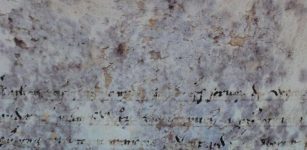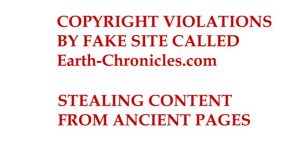Timeline Of Greek Dark Ages And Renaissance Is Wrong, New Research Shows
AncientPages.com - While ancient Greece is one of the best known cultures of antiquity, there are no surviving historical narratives covering events between 1200 and 760BC. This period has traditionally been viewed as a "dark age" on account of the lack of preserved written sources after much of the Mediterranean suffered a societal and political collapse.
Mosaic from Pompeii depicting Plato's Academy. Credit: Public Domain
The Greek iron ages occurred within this period. But, because of the lack of documents, till now historians have been working with a timeline, which uses pottery styles from Athens as its basis. Devised in the late 50s and 60s by the historians Nicolas Coldsteam and Vincent Desborough, it has been widely held that the iron ages begun in 1025 and ended in 700BC.
The "Greek renaissance", from 760BC to 700 BC, emerged in the iron ages' last period, known as the late geometric. This was a time of rapid economic and demographic growth that saw the adoption of alphabetic writing, the emergence of the Greek city-states, panhellenic sanctuaries and the establishment of Greek colonies abroad.
Such huge strides in 60 years, means that the period is considered extraordinary. However, new research from Assiros and Sindos in northern Greece, as well as Zagora on the Cycladic island of Andros suggests that this timeline of the Greek iron age is wrong. My recent work with the archaeologist Bartłomiej Lis on protogeometric pottery from the site of Eleon supports this view.
Together, our research indicates that the Greek dark ages could have been shorter and the Greek renaissance much longer than previously thought. This shows that Greek society was more resilient to the societal collapse that preceded the iron age than previously believed.
New pottery samples
Our study centers on a vessel discovered in 2013 by a team of archaeologists from the Ephorate of Antiquities of Boeotia and the Canadian Institute of Greece in a shrine dating to the last half of the 12th century BC in the ancient town of Eleon. This vessel, found crushed on the shrine's floor, features distinct sets of concentric circles pivoting around a central axis (a type of compass-like device) on its surface. A vase like this being discovered in a such an early context is unprecedented in central Greece.
The vessel's concentric circles are characteristic of the protogeometric style that Coldsteam and Desborough's believed to have emerged in Athens during the last half of the 11th century BC.
Coldsteam and Desborough established dates for the Greek iron ages through careful documentation of Greek pottery fragments in the Near East (an area covering roughly that of the modern Middle East). These fragments were found at sites which had been destroyed and leveled during historically attested wars.
So, using Near Eastern and Egyptian historical records of these incidents and by identifying the specific styles of the pottery fragments, Coldsteam and Desborough were able to give them specific dates. These were the protogeometric (1025–900BC), early geometric (900–850BC), middle geometric (850–760BC) and late geometric (760–700BC). The last being equivalent to the Greek renaissance.
Our research challenges this timeline and argues instead for an origin of the Protogeometric style during the 12th century BC in northern Greece and so proposes a new start date for the iron ages.
Our argument is supported by petrographic (analysis of thin sections of the pottery under a microscope) and chemical analyses conducted on the vase that show conclusively that it was imported from the lower Axios Valley. This happens to be the region where two other studies found results similarly challenging Coldsteam and Desborough's chronology of the early iron age between 2000s and 2020s.
An example of protogeometic pottery. Credit: The Met
As well as bolstering the revised timeline, our research introduces an added layer of complexity into the debate because the vessel from Eleon was found within a layer of Mycenaean pottery dating to the 12th century BC.
In the conventional chronology, Mycenaean-style pottery was produced from the 16th to 11th century BC and was succeeded by the protogeometric style towards the end of the 11th century BC. As Athens was believed to be the center responsible for creating the protogeometric style, no examples of it should be found in contexts earlier than the late 11th century BC.
The discovery at Eleon suggests that the protogeometric and mycenaean styles co-existed for a 100 years, rather than occurring one after each other. This means that the dark ages of Greece, could be much shorter than previously believed since the late geometric—and so the Greek renaissance, which saw the introduction of the alphabet—would begin over 100 years earlier.
The revised chronology emerging from our study proposes news dates for the iron age periods with most beginning around one hundred years earlier that believed. For instance, the protogeometric would begin around 1,150BC and end around 1,050BC instead of beginning 1025BC and ending 900BC. By moving all the start dates of the earlier periods forward, the late geometric becomes much longer since it would begin around 870BC rather that 760BC.
So, with its new start date of 870BC and its fixed end date of 700BC, the Greek renaissance spanned almost 200 years. It is certainly much less impressive then to consider all the strides of the period happening in two centuries instead of four decades.
Provided by The Conversation
This article is republished from The Conversation under a Creative Commons license. Read the original article.
More From Ancient Pages
-
 Collapse Of Akkadian Empire Strongly Related To Catastrophic Climate Change
Archaeology | Oct 28, 2019
Collapse Of Akkadian Empire Strongly Related To Catastrophic Climate Change
Archaeology | Oct 28, 2019 -
 Secrets Of A Lake That Could Re-Write Ancient History Of America – Myths And Gods Reveal A Complex Story – Part 1
Ancient Mysteries | Jun 4, 2018
Secrets Of A Lake That Could Re-Write Ancient History Of America – Myths And Gods Reveal A Complex Story – Part 1
Ancient Mysteries | Jun 4, 2018 -
 Smallest Ancient Thracian Brick Tomb – Discovered In Bulgaria
Archaeology | Oct 6, 2018
Smallest Ancient Thracian Brick Tomb – Discovered In Bulgaria
Archaeology | Oct 6, 2018 -
 Part Of Secret Vatican Manuscript Decoded
Archaeology | Sep 7, 2017
Part Of Secret Vatican Manuscript Decoded
Archaeology | Sep 7, 2017 -
 Hatra: Ancient Powerful Caravan City That Could Withstand Invading Roman Armies
Featured Stories | Dec 12, 2020
Hatra: Ancient Powerful Caravan City That Could Withstand Invading Roman Armies
Featured Stories | Dec 12, 2020 -
 Ancient Mesopotamian Discovery Changes Our Understanding Of Early Agriculture Practices
Archaeology | Jan 17, 2022
Ancient Mesopotamian Discovery Changes Our Understanding Of Early Agriculture Practices
Archaeology | Jan 17, 2022 -
 Archaeologists Search For The Tomb Of Biblical Joshua At Khirbet Tibnah
Archaeology | Aug 5, 2022
Archaeologists Search For The Tomb Of Biblical Joshua At Khirbet Tibnah
Archaeology | Aug 5, 2022 -
 Unsolved Ancient Mystery Of Lost Pre-Olmec Civilization – Evidence Of Advanced Scientific Knowledge That Could Re-Write History
Ancient Mysteries | Jul 16, 2018
Unsolved Ancient Mystery Of Lost Pre-Olmec Civilization – Evidence Of Advanced Scientific Knowledge That Could Re-Write History
Ancient Mysteries | Jul 16, 2018 -
 Amazing ‘Guennol Lioness’ – One Of The Greatest Ancient Works Of Art Of All Time
Artifacts | Sep 6, 2018
Amazing ‘Guennol Lioness’ – One Of The Greatest Ancient Works Of Art Of All Time
Artifacts | Sep 6, 2018 -
 Invention Of Ancient Military Technologies Throughout World History Investigated
Archaeology | Oct 23, 2021
Invention Of Ancient Military Technologies Throughout World History Investigated
Archaeology | Oct 23, 2021 -
 Copyright Violations By Earth-Chronicles.com – Fake Site That Steals Content From Ancient Pages Daily
News | Dec 28, 2017
Copyright Violations By Earth-Chronicles.com – Fake Site That Steals Content From Ancient Pages Daily
News | Dec 28, 2017 -
 On This Day In History: Johannes Kepler ‘Father Of Modern Astronomy’ Was Born – On Dec 27, 1571
News | Dec 27, 2016
On This Day In History: Johannes Kepler ‘Father Of Modern Astronomy’ Was Born – On Dec 27, 1571
News | Dec 27, 2016 -
 Nebra Disc – Artifact That Represents 3,600-Year-Old Astronomical Knowledge
Artifacts | May 26, 2014
Nebra Disc – Artifact That Represents 3,600-Year-Old Astronomical Knowledge
Artifacts | May 26, 2014 -
 3,800-Year-Old Cuneiform Clay Tablet With Agreement To Purchase A City Discovered In An Ancient Tumulus In Turkey
Archaeology | Aug 11, 2023
3,800-Year-Old Cuneiform Clay Tablet With Agreement To Purchase A City Discovered In An Ancient Tumulus In Turkey
Archaeology | Aug 11, 2023 -
 12,000-Year-Old Stones Found In Israel Could Be Earliest Evidence Of Wheel-Like Technology
Archaeology | Nov 13, 2024
12,000-Year-Old Stones Found In Israel Could Be Earliest Evidence Of Wheel-Like Technology
Archaeology | Nov 13, 2024 -
 Two Rare Funerary Busts Rescued From Destruction In Palmyra – Restored In Italy
Archaeology | Feb 25, 2017
Two Rare Funerary Busts Rescued From Destruction In Palmyra – Restored In Italy
Archaeology | Feb 25, 2017 -
 13,000-Year-Old Engraving May Depict First Paleolithic Social Group Of Humans
Archaeology | Dec 4, 2015
13,000-Year-Old Engraving May Depict First Paleolithic Social Group Of Humans
Archaeology | Dec 4, 2015 -
 Two Elite Burial Chambers Dated To Middle Kingdom Uncovered In Beni Hassan Necropolis, El-Minya, Egypt
Archaeology | Aug 6, 2018
Two Elite Burial Chambers Dated To Middle Kingdom Uncovered In Beni Hassan Necropolis, El-Minya, Egypt
Archaeology | Aug 6, 2018 -
 Was Napoleon Bonaparte Defeated At Waterloo Because Of Volcanic Eruption?
Archaeology | Aug 22, 2018
Was Napoleon Bonaparte Defeated At Waterloo Because Of Volcanic Eruption?
Archaeology | Aug 22, 2018 -
 Unexplained Mystery Of The Glowing Woman Who Baffled Scientists
Featured Stories | Jun 6, 2022
Unexplained Mystery Of The Glowing Woman Who Baffled Scientists
Featured Stories | Jun 6, 2022


